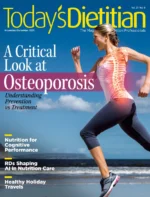Today’s Dietitian
Vol. 27 No. 2 P. 4
It’s no secret that conducting quality research in nutrition science is among the more difficult tasks. The highly interdependent system of metabolic pathways and biochemical processes inside a living body, each guided by many known and unknown factors such as genetics, dietary composition, the microbiome, lifestyle, and countless other environmental inputs, resists over-simplified reductionistic study designs. Isolating variables is a cornerstone of good science in one way, though removing too much of the context surrounding a subject of interest might not paint an accurate picture of how it functions and may mislead researchers in determining its impact on health outcomes.
Nutrition research is fraught with contradictory findings. Traditional study methodology—often highly reductionistic or linear—may ignore or minimize the contribution of other players in the system, including nonlinear phenomena like dose-dependent responses, which may make the difference between a given compound in question helping or harming. In nutrition science, this is never clearer than with nutrients themselves. As a common example, iodine deficiency is known to cause goiter; excess iodine will cause the same. If we snapped a separate photo of either moment, iodine would become the hero in the first and villain in the second.
In February’s issue, Today’s Dietitian features two articles unintentionally highlighting the challenge in nutrition research just described. In “L-carnitine and CVD,” we see the paradoxical action of L-carnitine as an agent of risk on one hand and therapeutic aid on the other, depending on a variety of factors. In “An Update on Nonnutritive Sweeteners,” we once again see the variable of dose play a part in determining potential risk.
Also in this issue, I am excited to introduce one of our new regular departments of 2025, Cultural Foodways. Celebrating the rich diversity of cultural traditions and tastes will take us around the world. Kicking it off, we’ll look at the seasonings and flavors of Mexico, appreciating the influence of its seven distinct culinary regions.
I hope you enjoy this month’s issue!
— Heather Davis, MS, RDN, LDN
TDeditor@gvpub.com


